Innovation and New Technologies: Tesla's AI Strategy and Impact
VerifiedAdded on 2023/01/10
|9
|3263
|58
Report
AI Summary
This report provides an overview of technological innovation, focusing on the application of Artificial Intelligence (AI) in business, particularly within the context of Tesla. It begins by defining technological innovation and highlighting current trends such as AI, IoT, and improved data security. The report then delves into Tesla's specific use of AI, detailing how the company leverages AI in its electric vehicles, especially in its autopilot system, to gain a competitive advantage. The analysis includes how Tesla utilizes data collection, AI-integrated chips, and collaboration with companies like Nvidia. Furthermore, the report explores the broader role and influence of AI in business and society, discussing its positive and negative impacts, including its role in automation, trend prediction, and customer service. The report concludes by emphasizing the importance of AI in enhancing efficiency and improving the overall customer experience, positioning AI as a key technological trend for the future. The report also explains how Tesla uses AI to make cars that can drive themselves and improve customer satisfaction.
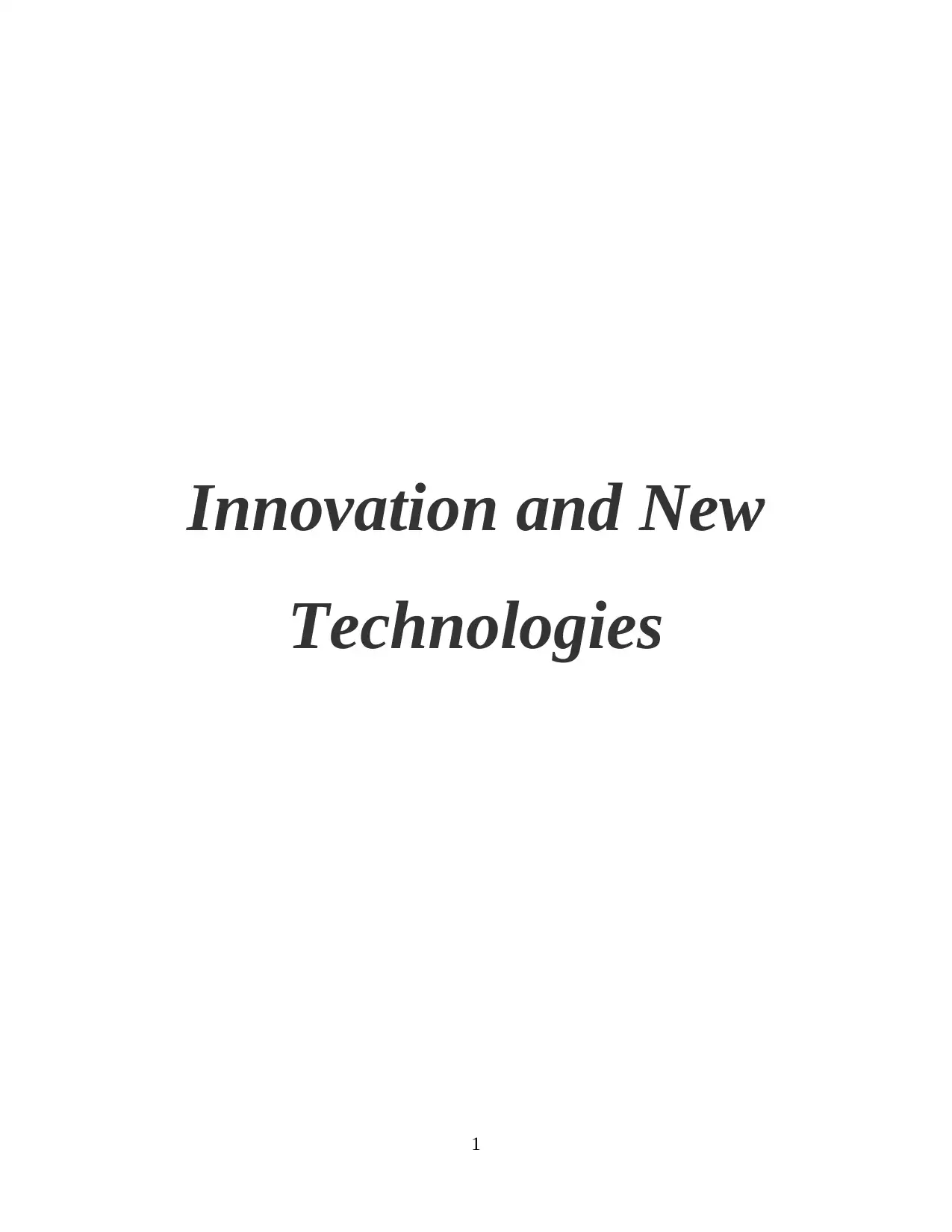
Innovation and New
Technologies
1
Technologies
1
Paraphrase This Document
Need a fresh take? Get an instant paraphrase of this document with our AI Paraphraser
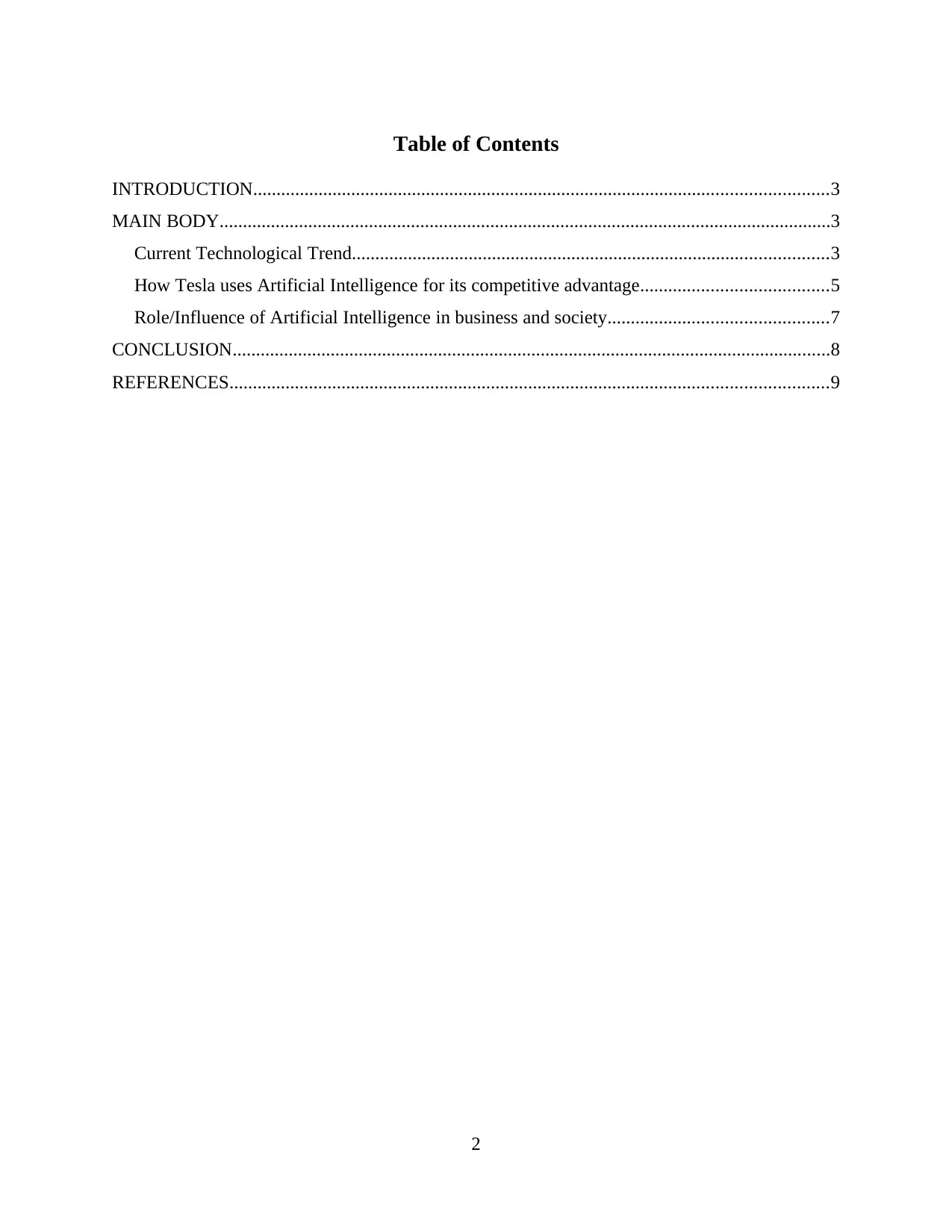
Table of Contents
INTRODUCTION...........................................................................................................................3
MAIN BODY...................................................................................................................................3
Current Technological Trend......................................................................................................3
How Tesla uses Artificial Intelligence for its competitive advantage........................................5
Role/Influence of Artificial Intelligence in business and society...............................................7
CONCLUSION................................................................................................................................8
REFERENCES................................................................................................................................9
2
INTRODUCTION...........................................................................................................................3
MAIN BODY...................................................................................................................................3
Current Technological Trend......................................................................................................3
How Tesla uses Artificial Intelligence for its competitive advantage........................................5
Role/Influence of Artificial Intelligence in business and society...............................................7
CONCLUSION................................................................................................................................8
REFERENCES................................................................................................................................9
2
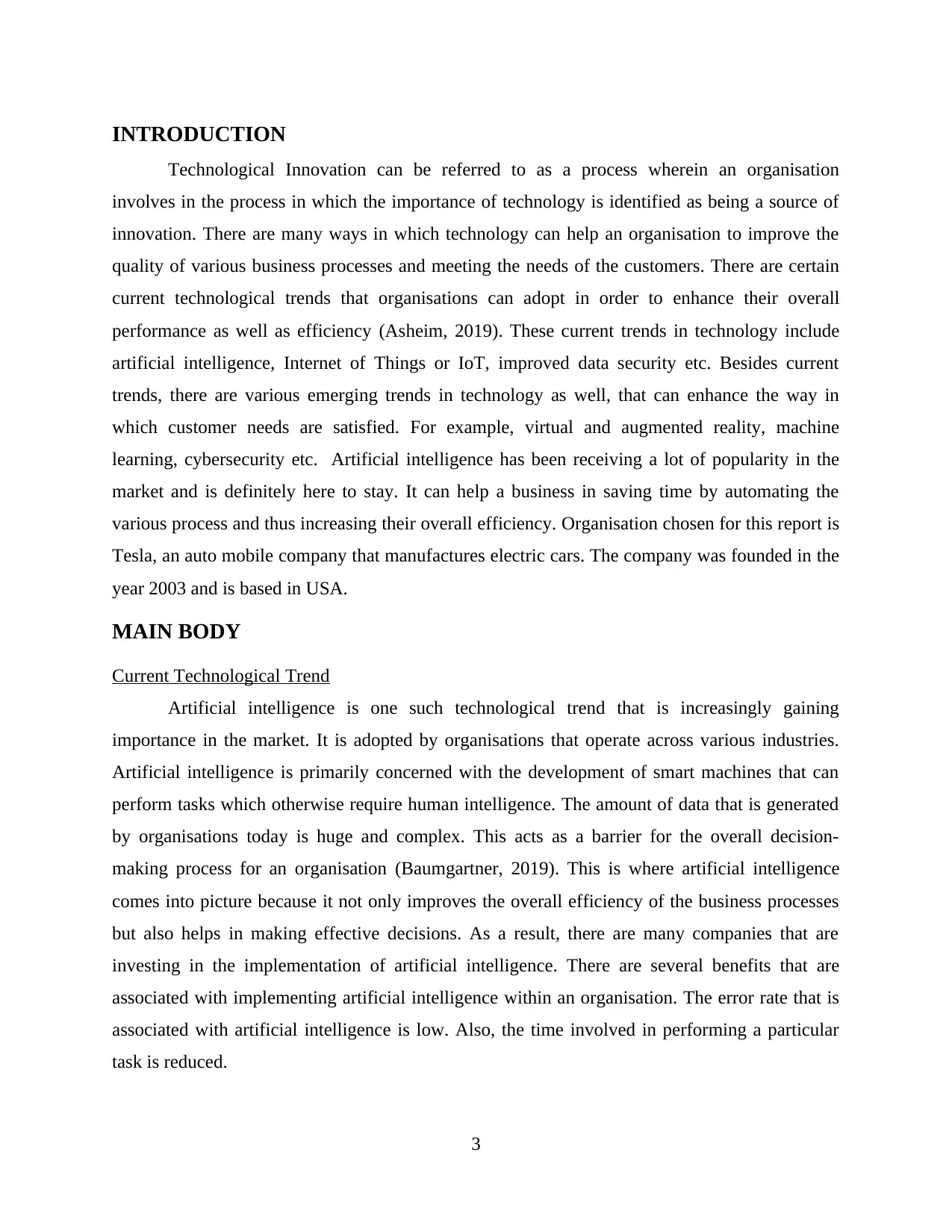
INTRODUCTION
Technological Innovation can be referred to as a process wherein an organisation
involves in the process in which the importance of technology is identified as being a source of
innovation. There are many ways in which technology can help an organisation to improve the
quality of various business processes and meeting the needs of the customers. There are certain
current technological trends that organisations can adopt in order to enhance their overall
performance as well as efficiency (Asheim, 2019). These current trends in technology include
artificial intelligence, Internet of Things or IoT, improved data security etc. Besides current
trends, there are various emerging trends in technology as well, that can enhance the way in
which customer needs are satisfied. For example, virtual and augmented reality, machine
learning, cybersecurity etc. Artificial intelligence has been receiving a lot of popularity in the
market and is definitely here to stay. It can help a business in saving time by automating the
various process and thus increasing their overall efficiency. Organisation chosen for this report is
Tesla, an auto mobile company that manufactures electric cars. The company was founded in the
year 2003 and is based in USA.
MAIN BODY
Current Technological Trend
Artificial intelligence is one such technological trend that is increasingly gaining
importance in the market. It is adopted by organisations that operate across various industries.
Artificial intelligence is primarily concerned with the development of smart machines that can
perform tasks which otherwise require human intelligence. The amount of data that is generated
by organisations today is huge and complex. This acts as a barrier for the overall decision-
making process for an organisation (Baumgartner, 2019). This is where artificial intelligence
comes into picture because it not only improves the overall efficiency of the business processes
but also helps in making effective decisions. As a result, there are many companies that are
investing in the implementation of artificial intelligence. There are several benefits that are
associated with implementing artificial intelligence within an organisation. The error rate that is
associated with artificial intelligence is low. Also, the time involved in performing a particular
task is reduced.
3
Technological Innovation can be referred to as a process wherein an organisation
involves in the process in which the importance of technology is identified as being a source of
innovation. There are many ways in which technology can help an organisation to improve the
quality of various business processes and meeting the needs of the customers. There are certain
current technological trends that organisations can adopt in order to enhance their overall
performance as well as efficiency (Asheim, 2019). These current trends in technology include
artificial intelligence, Internet of Things or IoT, improved data security etc. Besides current
trends, there are various emerging trends in technology as well, that can enhance the way in
which customer needs are satisfied. For example, virtual and augmented reality, machine
learning, cybersecurity etc. Artificial intelligence has been receiving a lot of popularity in the
market and is definitely here to stay. It can help a business in saving time by automating the
various process and thus increasing their overall efficiency. Organisation chosen for this report is
Tesla, an auto mobile company that manufactures electric cars. The company was founded in the
year 2003 and is based in USA.
MAIN BODY
Current Technological Trend
Artificial intelligence is one such technological trend that is increasingly gaining
importance in the market. It is adopted by organisations that operate across various industries.
Artificial intelligence is primarily concerned with the development of smart machines that can
perform tasks which otherwise require human intelligence. The amount of data that is generated
by organisations today is huge and complex. This acts as a barrier for the overall decision-
making process for an organisation (Baumgartner, 2019). This is where artificial intelligence
comes into picture because it not only improves the overall efficiency of the business processes
but also helps in making effective decisions. As a result, there are many companies that are
investing in the implementation of artificial intelligence. There are several benefits that are
associated with implementing artificial intelligence within an organisation. The error rate that is
associated with artificial intelligence is low. Also, the time involved in performing a particular
task is reduced.
3
⊘ This is a preview!⊘
Do you want full access?
Subscribe today to unlock all pages.

Trusted by 1+ million students worldwide
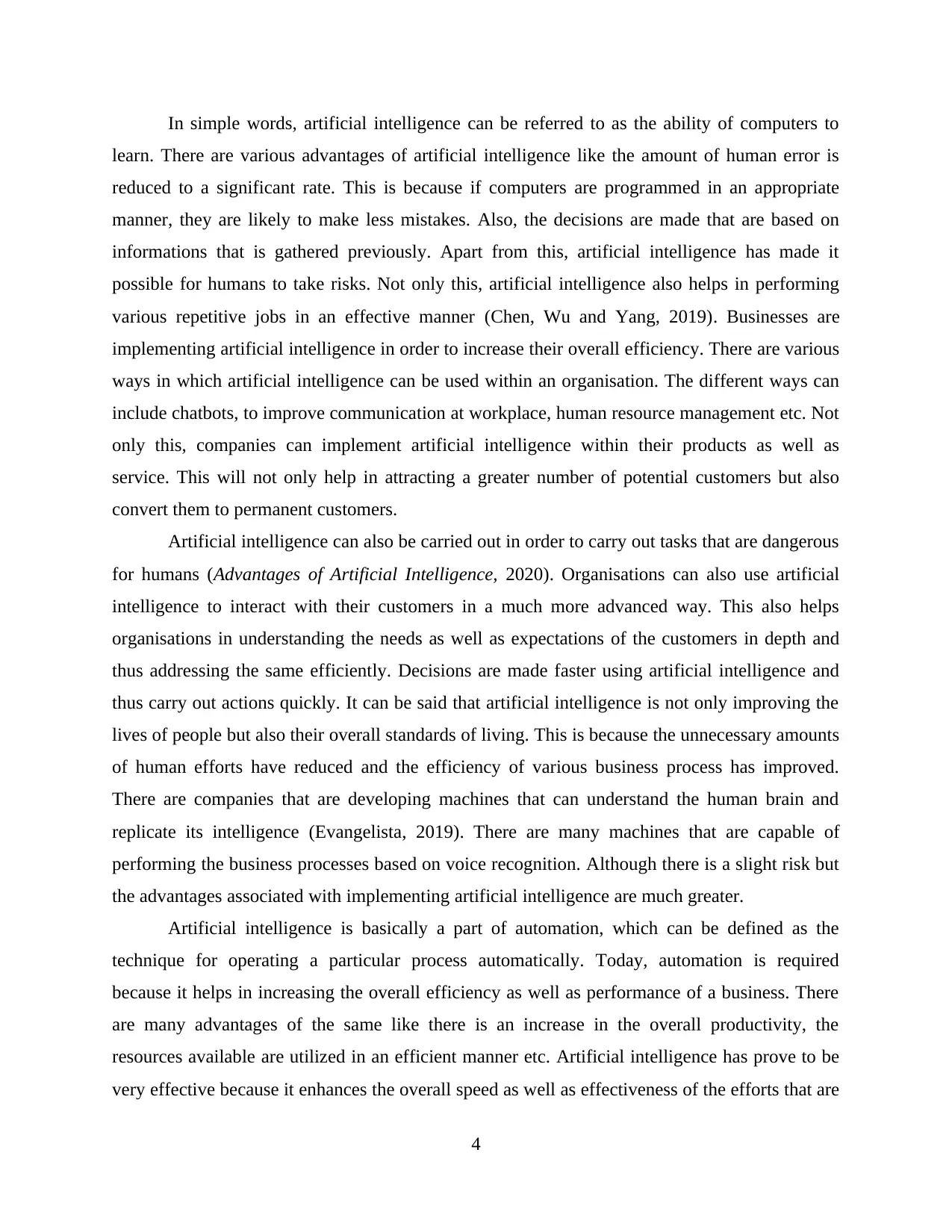
In simple words, artificial intelligence can be referred to as the ability of computers to
learn. There are various advantages of artificial intelligence like the amount of human error is
reduced to a significant rate. This is because if computers are programmed in an appropriate
manner, they are likely to make less mistakes. Also, the decisions are made that are based on
informations that is gathered previously. Apart from this, artificial intelligence has made it
possible for humans to take risks. Not only this, artificial intelligence also helps in performing
various repetitive jobs in an effective manner (Chen, Wu and Yang, 2019). Businesses are
implementing artificial intelligence in order to increase their overall efficiency. There are various
ways in which artificial intelligence can be used within an organisation. The different ways can
include chatbots, to improve communication at workplace, human resource management etc. Not
only this, companies can implement artificial intelligence within their products as well as
service. This will not only help in attracting a greater number of potential customers but also
convert them to permanent customers.
Artificial intelligence can also be carried out in order to carry out tasks that are dangerous
for humans (Advantages of Artificial Intelligence, 2020). Organisations can also use artificial
intelligence to interact with their customers in a much more advanced way. This also helps
organisations in understanding the needs as well as expectations of the customers in depth and
thus addressing the same efficiently. Decisions are made faster using artificial intelligence and
thus carry out actions quickly. It can be said that artificial intelligence is not only improving the
lives of people but also their overall standards of living. This is because the unnecessary amounts
of human efforts have reduced and the efficiency of various business process has improved.
There are companies that are developing machines that can understand the human brain and
replicate its intelligence (Evangelista, 2019). There are many machines that are capable of
performing the business processes based on voice recognition. Although there is a slight risk but
the advantages associated with implementing artificial intelligence are much greater.
Artificial intelligence is basically a part of automation, which can be defined as the
technique for operating a particular process automatically. Today, automation is required
because it helps in increasing the overall efficiency as well as performance of a business. There
are many advantages of the same like there is an increase in the overall productivity, the
resources available are utilized in an efficient manner etc. Artificial intelligence has prove to be
very effective because it enhances the overall speed as well as effectiveness of the efforts that are
4
learn. There are various advantages of artificial intelligence like the amount of human error is
reduced to a significant rate. This is because if computers are programmed in an appropriate
manner, they are likely to make less mistakes. Also, the decisions are made that are based on
informations that is gathered previously. Apart from this, artificial intelligence has made it
possible for humans to take risks. Not only this, artificial intelligence also helps in performing
various repetitive jobs in an effective manner (Chen, Wu and Yang, 2019). Businesses are
implementing artificial intelligence in order to increase their overall efficiency. There are various
ways in which artificial intelligence can be used within an organisation. The different ways can
include chatbots, to improve communication at workplace, human resource management etc. Not
only this, companies can implement artificial intelligence within their products as well as
service. This will not only help in attracting a greater number of potential customers but also
convert them to permanent customers.
Artificial intelligence can also be carried out in order to carry out tasks that are dangerous
for humans (Advantages of Artificial Intelligence, 2020). Organisations can also use artificial
intelligence to interact with their customers in a much more advanced way. This also helps
organisations in understanding the needs as well as expectations of the customers in depth and
thus addressing the same efficiently. Decisions are made faster using artificial intelligence and
thus carry out actions quickly. It can be said that artificial intelligence is not only improving the
lives of people but also their overall standards of living. This is because the unnecessary amounts
of human efforts have reduced and the efficiency of various business process has improved.
There are companies that are developing machines that can understand the human brain and
replicate its intelligence (Evangelista, 2019). There are many machines that are capable of
performing the business processes based on voice recognition. Although there is a slight risk but
the advantages associated with implementing artificial intelligence are much greater.
Artificial intelligence is basically a part of automation, which can be defined as the
technique for operating a particular process automatically. Today, automation is required
because it helps in increasing the overall efficiency as well as performance of a business. There
are many advantages of the same like there is an increase in the overall productivity, the
resources available are utilized in an efficient manner etc. Artificial intelligence has prove to be
very effective because it enhances the overall speed as well as effectiveness of the efforts that are
4
Paraphrase This Document
Need a fresh take? Get an instant paraphrase of this document with our AI Paraphraser
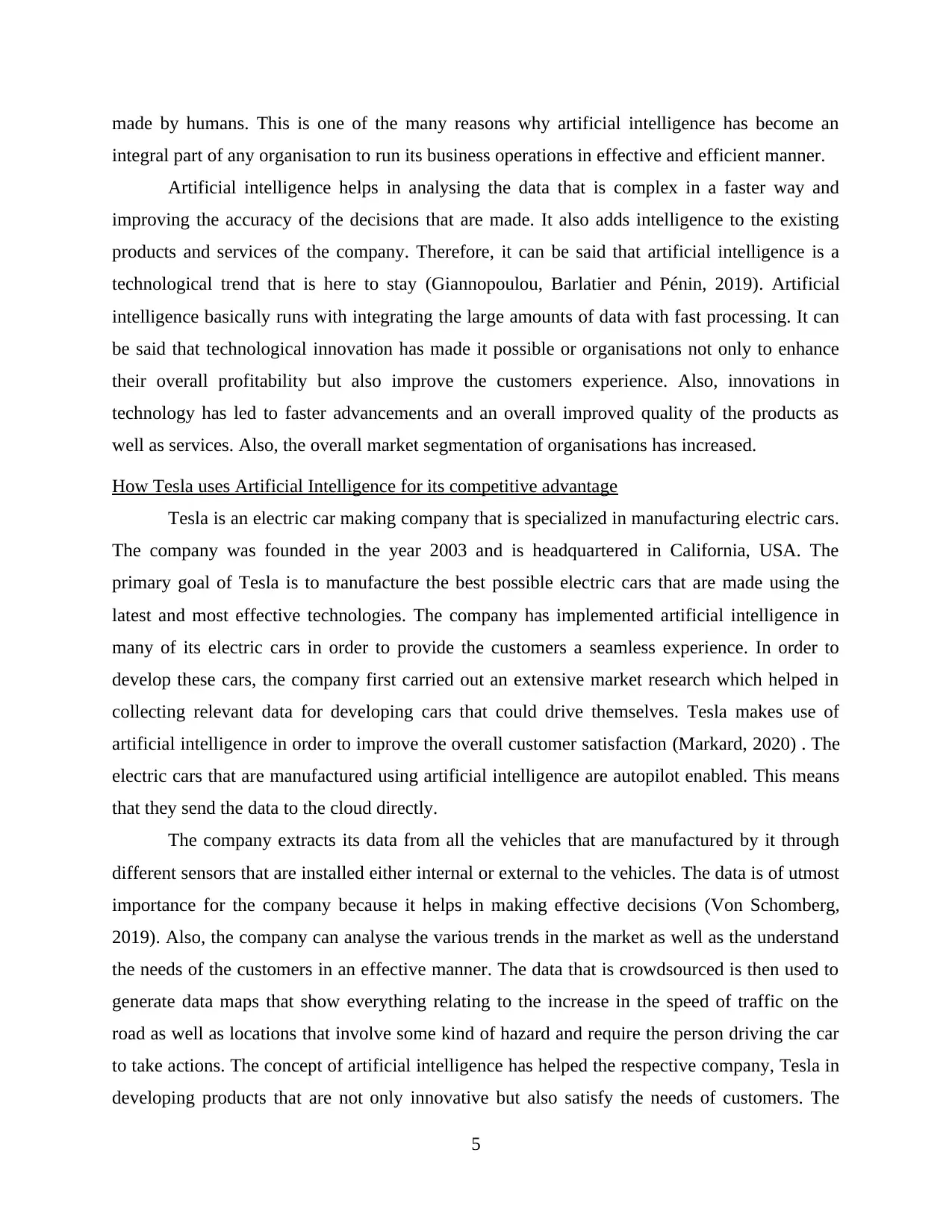
made by humans. This is one of the many reasons why artificial intelligence has become an
integral part of any organisation to run its business operations in effective and efficient manner.
Artificial intelligence helps in analysing the data that is complex in a faster way and
improving the accuracy of the decisions that are made. It also adds intelligence to the existing
products and services of the company. Therefore, it can be said that artificial intelligence is a
technological trend that is here to stay (Giannopoulou, Barlatier and Pénin, 2019). Artificial
intelligence basically runs with integrating the large amounts of data with fast processing. It can
be said that technological innovation has made it possible or organisations not only to enhance
their overall profitability but also improve the customers experience. Also, innovations in
technology has led to faster advancements and an overall improved quality of the products as
well as services. Also, the overall market segmentation of organisations has increased.
How Tesla uses Artificial Intelligence for its competitive advantage
Tesla is an electric car making company that is specialized in manufacturing electric cars.
The company was founded in the year 2003 and is headquartered in California, USA. The
primary goal of Tesla is to manufacture the best possible electric cars that are made using the
latest and most effective technologies. The company has implemented artificial intelligence in
many of its electric cars in order to provide the customers a seamless experience. In order to
develop these cars, the company first carried out an extensive market research which helped in
collecting relevant data for developing cars that could drive themselves. Tesla makes use of
artificial intelligence in order to improve the overall customer satisfaction (Markard, 2020) . The
electric cars that are manufactured using artificial intelligence are autopilot enabled. This means
that they send the data to the cloud directly.
The company extracts its data from all the vehicles that are manufactured by it through
different sensors that are installed either internal or external to the vehicles. The data is of utmost
importance for the company because it helps in making effective decisions (Von Schomberg,
2019). Also, the company can analyse the various trends in the market as well as the understand
the needs of the customers in an effective manner. The data that is crowdsourced is then used to
generate data maps that show everything relating to the increase in the speed of traffic on the
road as well as locations that involve some kind of hazard and require the person driving the car
to take actions. The concept of artificial intelligence has helped the respective company, Tesla in
developing products that are not only innovative but also satisfy the needs of customers. The
5
integral part of any organisation to run its business operations in effective and efficient manner.
Artificial intelligence helps in analysing the data that is complex in a faster way and
improving the accuracy of the decisions that are made. It also adds intelligence to the existing
products and services of the company. Therefore, it can be said that artificial intelligence is a
technological trend that is here to stay (Giannopoulou, Barlatier and Pénin, 2019). Artificial
intelligence basically runs with integrating the large amounts of data with fast processing. It can
be said that technological innovation has made it possible or organisations not only to enhance
their overall profitability but also improve the customers experience. Also, innovations in
technology has led to faster advancements and an overall improved quality of the products as
well as services. Also, the overall market segmentation of organisations has increased.
How Tesla uses Artificial Intelligence for its competitive advantage
Tesla is an electric car making company that is specialized in manufacturing electric cars.
The company was founded in the year 2003 and is headquartered in California, USA. The
primary goal of Tesla is to manufacture the best possible electric cars that are made using the
latest and most effective technologies. The company has implemented artificial intelligence in
many of its electric cars in order to provide the customers a seamless experience. In order to
develop these cars, the company first carried out an extensive market research which helped in
collecting relevant data for developing cars that could drive themselves. Tesla makes use of
artificial intelligence in order to improve the overall customer satisfaction (Markard, 2020) . The
electric cars that are manufactured using artificial intelligence are autopilot enabled. This means
that they send the data to the cloud directly.
The company extracts its data from all the vehicles that are manufactured by it through
different sensors that are installed either internal or external to the vehicles. The data is of utmost
importance for the company because it helps in making effective decisions (Von Schomberg,
2019). Also, the company can analyse the various trends in the market as well as the understand
the needs of the customers in an effective manner. The data that is crowdsourced is then used to
generate data maps that show everything relating to the increase in the speed of traffic on the
road as well as locations that involve some kind of hazard and require the person driving the car
to take actions. The concept of artificial intelligence has helped the respective company, Tesla in
developing products that are not only innovative but also satisfy the needs of customers. The
5
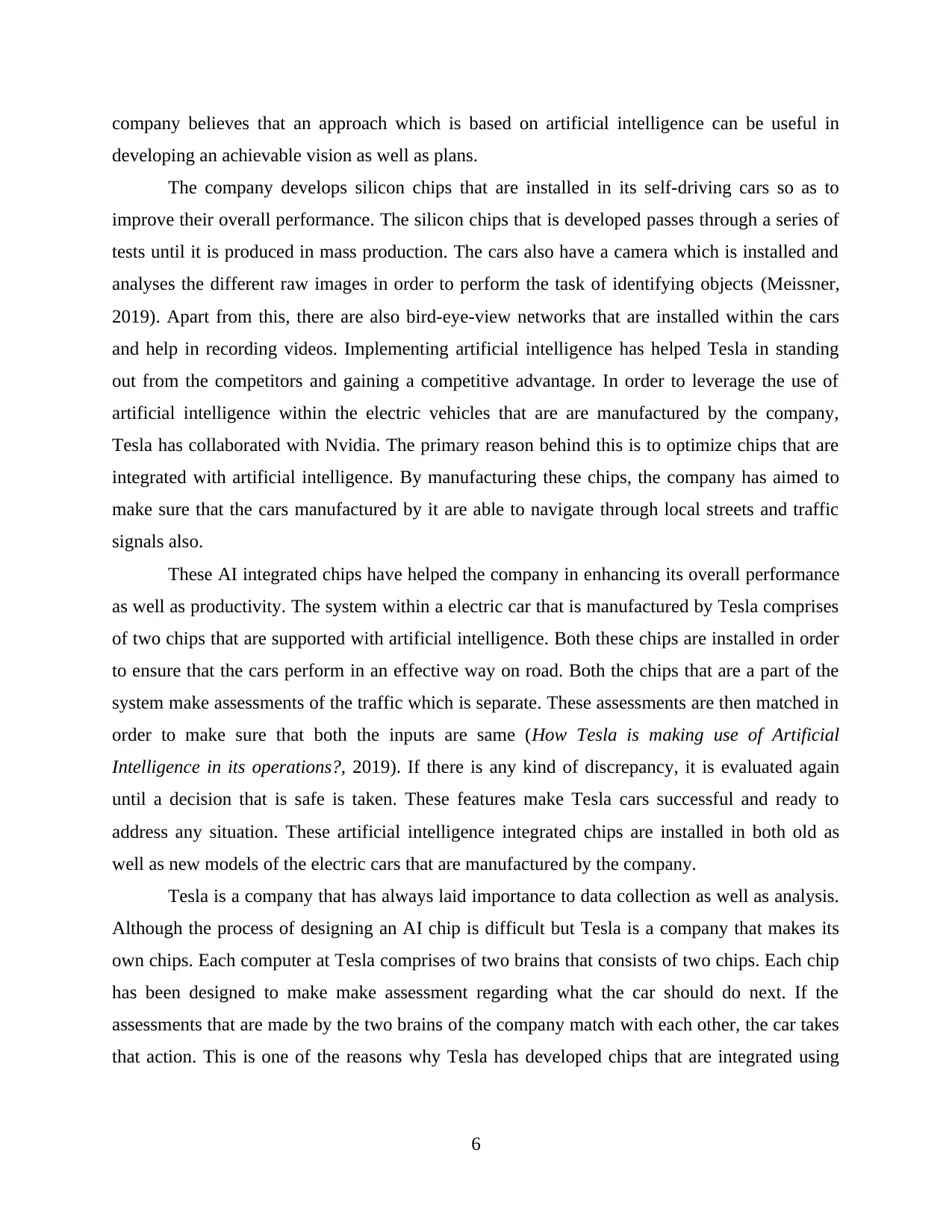
company believes that an approach which is based on artificial intelligence can be useful in
developing an achievable vision as well as plans.
The company develops silicon chips that are installed in its self-driving cars so as to
improve their overall performance. The silicon chips that is developed passes through a series of
tests until it is produced in mass production. The cars also have a camera which is installed and
analyses the different raw images in order to perform the task of identifying objects (Meissner,
2019). Apart from this, there are also bird-eye-view networks that are installed within the cars
and help in recording videos. Implementing artificial intelligence has helped Tesla in standing
out from the competitors and gaining a competitive advantage. In order to leverage the use of
artificial intelligence within the electric vehicles that are are manufactured by the company,
Tesla has collaborated with Nvidia. The primary reason behind this is to optimize chips that are
integrated with artificial intelligence. By manufacturing these chips, the company has aimed to
make sure that the cars manufactured by it are able to navigate through local streets and traffic
signals also.
These AI integrated chips have helped the company in enhancing its overall performance
as well as productivity. The system within a electric car that is manufactured by Tesla comprises
of two chips that are supported with artificial intelligence. Both these chips are installed in order
to ensure that the cars perform in an effective way on road. Both the chips that are a part of the
system make assessments of the traffic which is separate. These assessments are then matched in
order to make sure that both the inputs are same (How Tesla is making use of Artificial
Intelligence in its operations?, 2019). If there is any kind of discrepancy, it is evaluated again
until a decision that is safe is taken. These features make Tesla cars successful and ready to
address any situation. These artificial intelligence integrated chips are installed in both old as
well as new models of the electric cars that are manufactured by the company.
Tesla is a company that has always laid importance to data collection as well as analysis.
Although the process of designing an AI chip is difficult but Tesla is a company that makes its
own chips. Each computer at Tesla comprises of two brains that consists of two chips. Each chip
has been designed to make make assessment regarding what the car should do next. If the
assessments that are made by the two brains of the company match with each other, the car takes
that action. This is one of the reasons why Tesla has developed chips that are integrated using
6
developing an achievable vision as well as plans.
The company develops silicon chips that are installed in its self-driving cars so as to
improve their overall performance. The silicon chips that is developed passes through a series of
tests until it is produced in mass production. The cars also have a camera which is installed and
analyses the different raw images in order to perform the task of identifying objects (Meissner,
2019). Apart from this, there are also bird-eye-view networks that are installed within the cars
and help in recording videos. Implementing artificial intelligence has helped Tesla in standing
out from the competitors and gaining a competitive advantage. In order to leverage the use of
artificial intelligence within the electric vehicles that are are manufactured by the company,
Tesla has collaborated with Nvidia. The primary reason behind this is to optimize chips that are
integrated with artificial intelligence. By manufacturing these chips, the company has aimed to
make sure that the cars manufactured by it are able to navigate through local streets and traffic
signals also.
These AI integrated chips have helped the company in enhancing its overall performance
as well as productivity. The system within a electric car that is manufactured by Tesla comprises
of two chips that are supported with artificial intelligence. Both these chips are installed in order
to ensure that the cars perform in an effective way on road. Both the chips that are a part of the
system make assessments of the traffic which is separate. These assessments are then matched in
order to make sure that both the inputs are same (How Tesla is making use of Artificial
Intelligence in its operations?, 2019). If there is any kind of discrepancy, it is evaluated again
until a decision that is safe is taken. These features make Tesla cars successful and ready to
address any situation. These artificial intelligence integrated chips are installed in both old as
well as new models of the electric cars that are manufactured by the company.
Tesla is a company that has always laid importance to data collection as well as analysis.
Although the process of designing an AI chip is difficult but Tesla is a company that makes its
own chips. Each computer at Tesla comprises of two brains that consists of two chips. Each chip
has been designed to make make assessment regarding what the car should do next. If the
assessments that are made by the two brains of the company match with each other, the car takes
that action. This is one of the reasons why Tesla has developed chips that are integrated using
6
⊘ This is a preview!⊘
Do you want full access?
Subscribe today to unlock all pages.

Trusted by 1+ million students worldwide
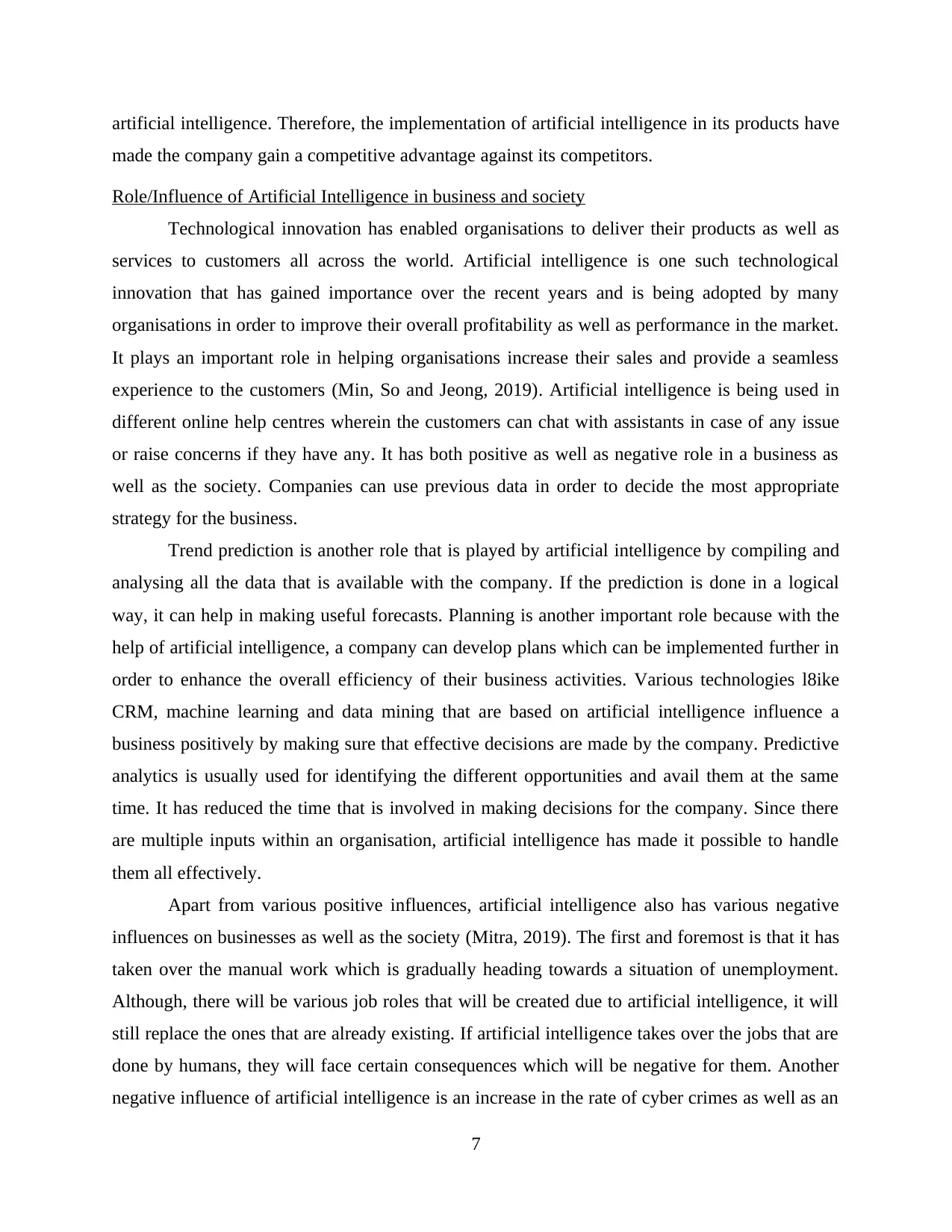
artificial intelligence. Therefore, the implementation of artificial intelligence in its products have
made the company gain a competitive advantage against its competitors.
Role/Influence of Artificial Intelligence in business and society
Technological innovation has enabled organisations to deliver their products as well as
services to customers all across the world. Artificial intelligence is one such technological
innovation that has gained importance over the recent years and is being adopted by many
organisations in order to improve their overall profitability as well as performance in the market.
It plays an important role in helping organisations increase their sales and provide a seamless
experience to the customers (Min, So and Jeong, 2019). Artificial intelligence is being used in
different online help centres wherein the customers can chat with assistants in case of any issue
or raise concerns if they have any. It has both positive as well as negative role in a business as
well as the society. Companies can use previous data in order to decide the most appropriate
strategy for the business.
Trend prediction is another role that is played by artificial intelligence by compiling and
analysing all the data that is available with the company. If the prediction is done in a logical
way, it can help in making useful forecasts. Planning is another important role because with the
help of artificial intelligence, a company can develop plans which can be implemented further in
order to enhance the overall efficiency of their business activities. Various technologies l8ike
CRM, machine learning and data mining that are based on artificial intelligence influence a
business positively by making sure that effective decisions are made by the company. Predictive
analytics is usually used for identifying the different opportunities and avail them at the same
time. It has reduced the time that is involved in making decisions for the company. Since there
are multiple inputs within an organisation, artificial intelligence has made it possible to handle
them all effectively.
Apart from various positive influences, artificial intelligence also has various negative
influences on businesses as well as the society (Mitra, 2019). The first and foremost is that it has
taken over the manual work which is gradually heading towards a situation of unemployment.
Although, there will be various job roles that will be created due to artificial intelligence, it will
still replace the ones that are already existing. If artificial intelligence takes over the jobs that are
done by humans, they will face certain consequences which will be negative for them. Another
negative influence of artificial intelligence is an increase in the rate of cyber crimes as well as an
7
made the company gain a competitive advantage against its competitors.
Role/Influence of Artificial Intelligence in business and society
Technological innovation has enabled organisations to deliver their products as well as
services to customers all across the world. Artificial intelligence is one such technological
innovation that has gained importance over the recent years and is being adopted by many
organisations in order to improve their overall profitability as well as performance in the market.
It plays an important role in helping organisations increase their sales and provide a seamless
experience to the customers (Min, So and Jeong, 2019). Artificial intelligence is being used in
different online help centres wherein the customers can chat with assistants in case of any issue
or raise concerns if they have any. It has both positive as well as negative role in a business as
well as the society. Companies can use previous data in order to decide the most appropriate
strategy for the business.
Trend prediction is another role that is played by artificial intelligence by compiling and
analysing all the data that is available with the company. If the prediction is done in a logical
way, it can help in making useful forecasts. Planning is another important role because with the
help of artificial intelligence, a company can develop plans which can be implemented further in
order to enhance the overall efficiency of their business activities. Various technologies l8ike
CRM, machine learning and data mining that are based on artificial intelligence influence a
business positively by making sure that effective decisions are made by the company. Predictive
analytics is usually used for identifying the different opportunities and avail them at the same
time. It has reduced the time that is involved in making decisions for the company. Since there
are multiple inputs within an organisation, artificial intelligence has made it possible to handle
them all effectively.
Apart from various positive influences, artificial intelligence also has various negative
influences on businesses as well as the society (Mitra, 2019). The first and foremost is that it has
taken over the manual work which is gradually heading towards a situation of unemployment.
Although, there will be various job roles that will be created due to artificial intelligence, it will
still replace the ones that are already existing. If artificial intelligence takes over the jobs that are
done by humans, they will face certain consequences which will be negative for them. Another
negative influence of artificial intelligence is an increase in the rate of cyber crimes as well as an
7
Paraphrase This Document
Need a fresh take? Get an instant paraphrase of this document with our AI Paraphraser
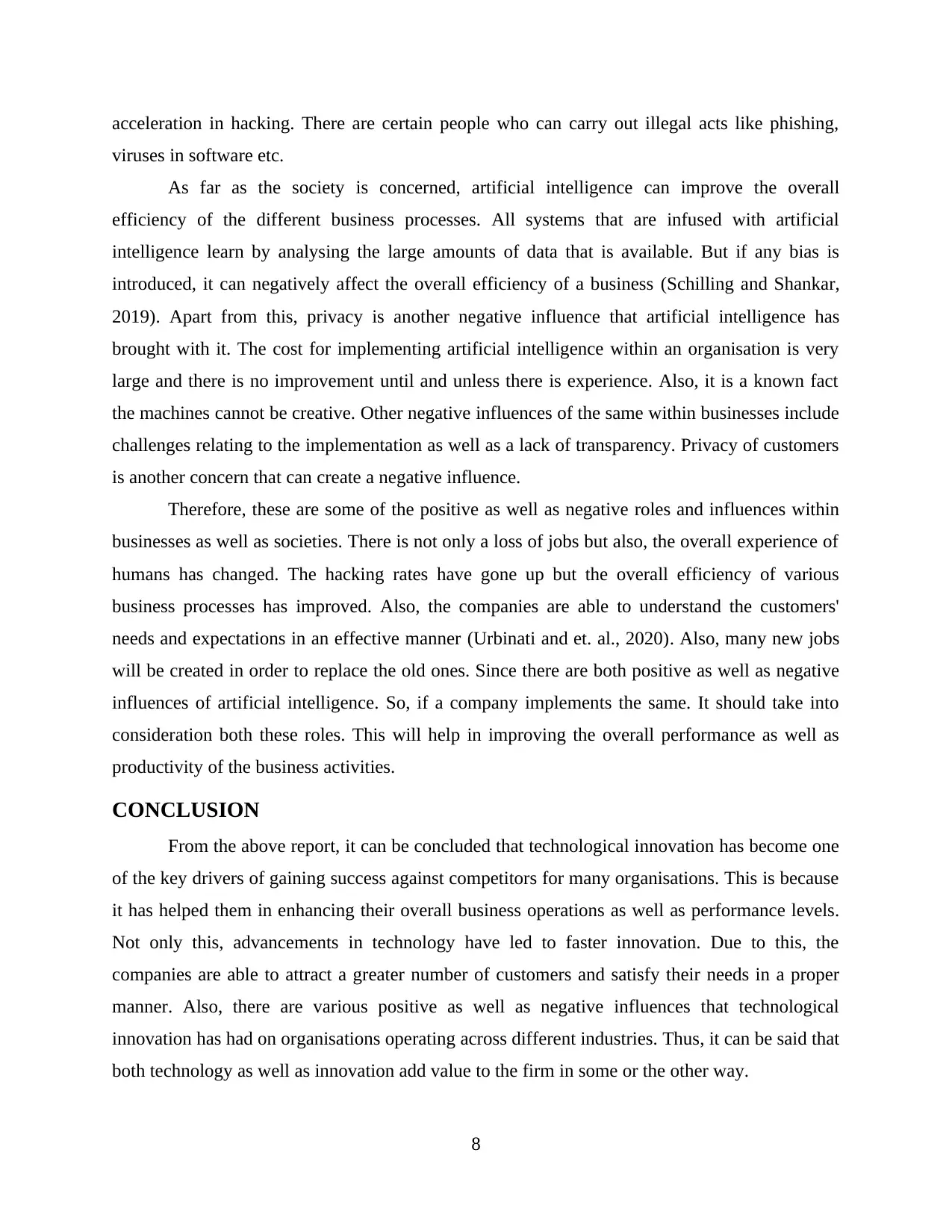
acceleration in hacking. There are certain people who can carry out illegal acts like phishing,
viruses in software etc.
As far as the society is concerned, artificial intelligence can improve the overall
efficiency of the different business processes. All systems that are infused with artificial
intelligence learn by analysing the large amounts of data that is available. But if any bias is
introduced, it can negatively affect the overall efficiency of a business (Schilling and Shankar,
2019). Apart from this, privacy is another negative influence that artificial intelligence has
brought with it. The cost for implementing artificial intelligence within an organisation is very
large and there is no improvement until and unless there is experience. Also, it is a known fact
the machines cannot be creative. Other negative influences of the same within businesses include
challenges relating to the implementation as well as a lack of transparency. Privacy of customers
is another concern that can create a negative influence.
Therefore, these are some of the positive as well as negative roles and influences within
businesses as well as societies. There is not only a loss of jobs but also, the overall experience of
humans has changed. The hacking rates have gone up but the overall efficiency of various
business processes has improved. Also, the companies are able to understand the customers'
needs and expectations in an effective manner (Urbinati and et. al., 2020). Also, many new jobs
will be created in order to replace the old ones. Since there are both positive as well as negative
influences of artificial intelligence. So, if a company implements the same. It should take into
consideration both these roles. This will help in improving the overall performance as well as
productivity of the business activities.
CONCLUSION
From the above report, it can be concluded that technological innovation has become one
of the key drivers of gaining success against competitors for many organisations. This is because
it has helped them in enhancing their overall business operations as well as performance levels.
Not only this, advancements in technology have led to faster innovation. Due to this, the
companies are able to attract a greater number of customers and satisfy their needs in a proper
manner. Also, there are various positive as well as negative influences that technological
innovation has had on organisations operating across different industries. Thus, it can be said that
both technology as well as innovation add value to the firm in some or the other way.
8
viruses in software etc.
As far as the society is concerned, artificial intelligence can improve the overall
efficiency of the different business processes. All systems that are infused with artificial
intelligence learn by analysing the large amounts of data that is available. But if any bias is
introduced, it can negatively affect the overall efficiency of a business (Schilling and Shankar,
2019). Apart from this, privacy is another negative influence that artificial intelligence has
brought with it. The cost for implementing artificial intelligence within an organisation is very
large and there is no improvement until and unless there is experience. Also, it is a known fact
the machines cannot be creative. Other negative influences of the same within businesses include
challenges relating to the implementation as well as a lack of transparency. Privacy of customers
is another concern that can create a negative influence.
Therefore, these are some of the positive as well as negative roles and influences within
businesses as well as societies. There is not only a loss of jobs but also, the overall experience of
humans has changed. The hacking rates have gone up but the overall efficiency of various
business processes has improved. Also, the companies are able to understand the customers'
needs and expectations in an effective manner (Urbinati and et. al., 2020). Also, many new jobs
will be created in order to replace the old ones. Since there are both positive as well as negative
influences of artificial intelligence. So, if a company implements the same. It should take into
consideration both these roles. This will help in improving the overall performance as well as
productivity of the business activities.
CONCLUSION
From the above report, it can be concluded that technological innovation has become one
of the key drivers of gaining success against competitors for many organisations. This is because
it has helped them in enhancing their overall business operations as well as performance levels.
Not only this, advancements in technology have led to faster innovation. Due to this, the
companies are able to attract a greater number of customers and satisfy their needs in a proper
manner. Also, there are various positive as well as negative influences that technological
innovation has had on organisations operating across different industries. Thus, it can be said that
both technology as well as innovation add value to the firm in some or the other way.
8
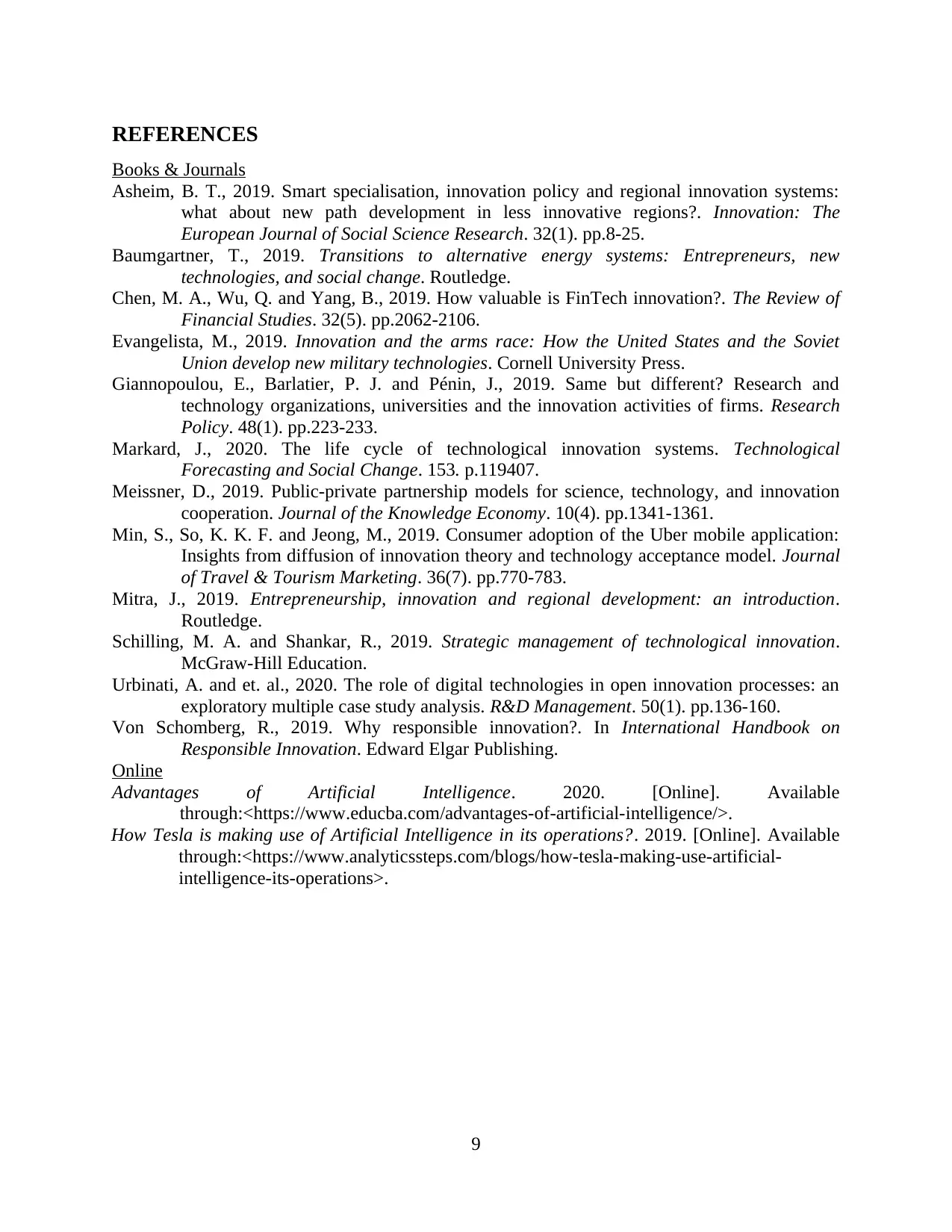
REFERENCES
Books & Journals
Asheim, B. T., 2019. Smart specialisation, innovation policy and regional innovation systems:
what about new path development in less innovative regions?. Innovation: The
European Journal of Social Science Research. 32(1). pp.8-25.
Baumgartner, T., 2019. Transitions to alternative energy systems: Entrepreneurs, new
technologies, and social change. Routledge.
Chen, M. A., Wu, Q. and Yang, B., 2019. How valuable is FinTech innovation?. The Review of
Financial Studies. 32(5). pp.2062-2106.
Evangelista, M., 2019. Innovation and the arms race: How the United States and the Soviet
Union develop new military technologies. Cornell University Press.
Giannopoulou, E., Barlatier, P. J. and Pénin, J., 2019. Same but different? Research and
technology organizations, universities and the innovation activities of firms. Research
Policy. 48(1). pp.223-233.
Markard, J., 2020. The life cycle of technological innovation systems. Technological
Forecasting and Social Change. 153. p.119407.
Meissner, D., 2019. Public-private partnership models for science, technology, and innovation
cooperation. Journal of the Knowledge Economy. 10(4). pp.1341-1361.
Min, S., So, K. K. F. and Jeong, M., 2019. Consumer adoption of the Uber mobile application:
Insights from diffusion of innovation theory and technology acceptance model. Journal
of Travel & Tourism Marketing. 36(7). pp.770-783.
Mitra, J., 2019. Entrepreneurship, innovation and regional development: an introduction.
Routledge.
Schilling, M. A. and Shankar, R., 2019. Strategic management of technological innovation.
McGraw-Hill Education.
Urbinati, A. and et. al., 2020. The role of digital technologies in open innovation processes: an
exploratory multiple case study analysis. R&D Management. 50(1). pp.136-160.
Von Schomberg, R., 2019. Why responsible innovation?. In International Handbook on
Responsible Innovation. Edward Elgar Publishing.
Online
Advantages of Artificial Intelligence. 2020. [Online]. Available
through:<https://www.educba.com/advantages-of-artificial-intelligence/>.
How Tesla is making use of Artificial Intelligence in its operations?. 2019. [Online]. Available
through:<https://www.analyticssteps.com/blogs/how-tesla-making-use-artificial-
intelligence-its-operations>.
9
Books & Journals
Asheim, B. T., 2019. Smart specialisation, innovation policy and regional innovation systems:
what about new path development in less innovative regions?. Innovation: The
European Journal of Social Science Research. 32(1). pp.8-25.
Baumgartner, T., 2019. Transitions to alternative energy systems: Entrepreneurs, new
technologies, and social change. Routledge.
Chen, M. A., Wu, Q. and Yang, B., 2019. How valuable is FinTech innovation?. The Review of
Financial Studies. 32(5). pp.2062-2106.
Evangelista, M., 2019. Innovation and the arms race: How the United States and the Soviet
Union develop new military technologies. Cornell University Press.
Giannopoulou, E., Barlatier, P. J. and Pénin, J., 2019. Same but different? Research and
technology organizations, universities and the innovation activities of firms. Research
Policy. 48(1). pp.223-233.
Markard, J., 2020. The life cycle of technological innovation systems. Technological
Forecasting and Social Change. 153. p.119407.
Meissner, D., 2019. Public-private partnership models for science, technology, and innovation
cooperation. Journal of the Knowledge Economy. 10(4). pp.1341-1361.
Min, S., So, K. K. F. and Jeong, M., 2019. Consumer adoption of the Uber mobile application:
Insights from diffusion of innovation theory and technology acceptance model. Journal
of Travel & Tourism Marketing. 36(7). pp.770-783.
Mitra, J., 2019. Entrepreneurship, innovation and regional development: an introduction.
Routledge.
Schilling, M. A. and Shankar, R., 2019. Strategic management of technological innovation.
McGraw-Hill Education.
Urbinati, A. and et. al., 2020. The role of digital technologies in open innovation processes: an
exploratory multiple case study analysis. R&D Management. 50(1). pp.136-160.
Von Schomberg, R., 2019. Why responsible innovation?. In International Handbook on
Responsible Innovation. Edward Elgar Publishing.
Online
Advantages of Artificial Intelligence. 2020. [Online]. Available
through:<https://www.educba.com/advantages-of-artificial-intelligence/>.
How Tesla is making use of Artificial Intelligence in its operations?. 2019. [Online]. Available
through:<https://www.analyticssteps.com/blogs/how-tesla-making-use-artificial-
intelligence-its-operations>.
9
⊘ This is a preview!⊘
Do you want full access?
Subscribe today to unlock all pages.

Trusted by 1+ million students worldwide
1 out of 9
Related Documents
Your All-in-One AI-Powered Toolkit for Academic Success.
+13062052269
info@desklib.com
Available 24*7 on WhatsApp / Email
![[object Object]](/_next/static/media/star-bottom.7253800d.svg)
Unlock your academic potential
Copyright © 2020–2025 A2Z Services. All Rights Reserved. Developed and managed by ZUCOL.




